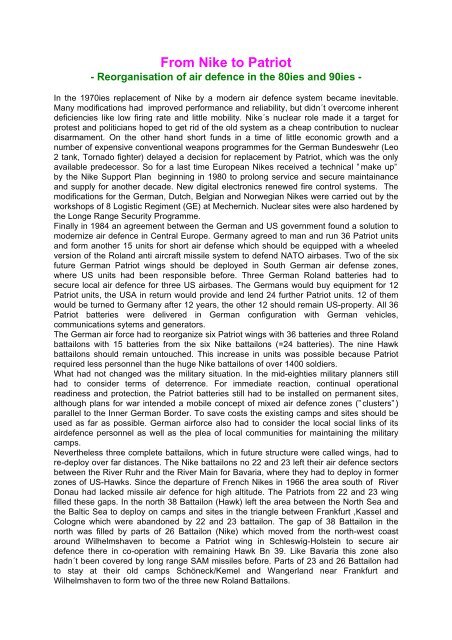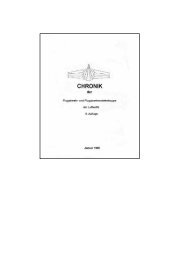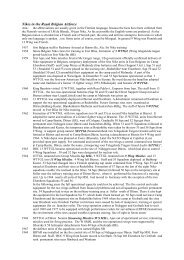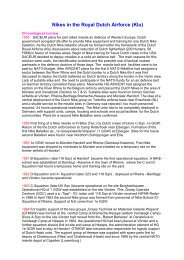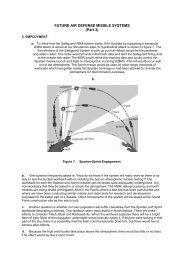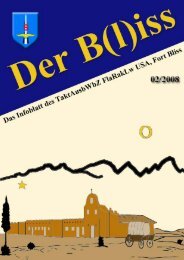From NIKE to PATRIOT - Rolfs NIKE Pages
From NIKE to PATRIOT - Rolfs NIKE Pages
From NIKE to PATRIOT - Rolfs NIKE Pages
You also want an ePaper? Increase the reach of your titles
YUMPU automatically turns print PDFs into web optimized ePapers that Google loves.
<strong>From</strong> Nike <strong>to</strong> Patriot<br />
- Reorganisation of air defence in the 80ies and 90ies -<br />
In the 1970ies replacement of Nike by a modern air defence system became inevitable.<br />
Many modifications had improved performance and reliability, but didn´t overcome inherent<br />
deficiencies like low firing rate and little mobility. Nike´s nuclear role made it a target for<br />
protest and politicians hoped <strong>to</strong> get rid of the old system as a cheap contribution <strong>to</strong> nuclear<br />
disarmament. On the other hand short funds in a time of little economic growth and a<br />
number of expensive conventional weapons programmes for the German Bundeswehr (Leo<br />
2 tank, Tornado fighter) delayed a decision for replacement by Patriot, which was the only<br />
available predecessor. So for a last time European Nikes received a technical ”make up”<br />
by the Nike Support Plan beginning in 1980 <strong>to</strong> prolong service and secure maintainance<br />
and supply for another decade. New digital electronics renewed fire control systems. The<br />
modifications for the German, Dutch, Belgian and Norwegian Nikes were carried out by the<br />
workshops of 8 Logistic Regiment (GE) at Mechernich. Nuclear sites were also hardened by<br />
the Longe Range Security Programme.<br />
Finally in 1984 an agreement between the German and US government found a solution <strong>to</strong><br />
modernize air defence in Central Europe. Germany agreed <strong>to</strong> man and run 36 Patriot units<br />
and form another 15 units for short air defense which should be equipped with a wheeled<br />
version of the Roland anti aircraft missile system <strong>to</strong> defend NATO airbases. Two of the six<br />
future German Patriot wings should be deployed in South German air defense zones,<br />
where US units had been responsible before. Three German Roland batteries had <strong>to</strong><br />
secure local air defence for three US airbases. The Germans would buy equipment for 12<br />
Patriot units, the USA in return would provide and lend 24 further Patriot units. 12 of them<br />
would be turned <strong>to</strong> Germany after 12 years, the other 12 should remain US-property. All 36<br />
Patriot batteries were delivered in German configuration with German vehicles,<br />
communications sytems and genera<strong>to</strong>rs.<br />
The German air force had <strong>to</strong> reorganize six Patriot wings with 36 batteries and three Roland<br />
battailons with 15 batteries from the six Nike battailons (=24 batteries). The nine Hawk<br />
battailons should remain un<strong>to</strong>uched. This increase in units was possible because Patriot<br />
required less personnel than the huge Nike battailons of over 1400 soldiers.<br />
What had not changed was the military situation. In the mid-eighties military planners still<br />
had <strong>to</strong> consider terms of deterrence. For immediate reaction, continual operational<br />
readiness and protection, the Patriot batteries still had <strong>to</strong> be installed on permanent sites,<br />
although plans for war intended a mobile concept of mixed air defence zones (”clusters”)<br />
parallel <strong>to</strong> the Inner German Border. To save costs the existing camps and sites should be<br />
used as far as possible. German airforce also had <strong>to</strong> consider the local social links of its<br />
airdefence personnel as well as the plea of local communities for maintaining the military<br />
camps.<br />
Nevertheless three complete battailons, which in future structure were called wings, had <strong>to</strong><br />
re-deploy over far distances. The Nike battailons no 22 and 23 left their air defence sec<strong>to</strong>rs<br />
between the River Ruhr and the River Main for Bavaria, where they had <strong>to</strong> deploy in former<br />
zones of US-Hawks. Since the departure of French Nikes in 1966 the area south of River<br />
Donau had lacked missile air defence for high altitude. The Patriots from 22 and 23 wing<br />
filled these gaps. In the north 38 Battailon (Hawk) left the area between the North Sea and<br />
the Baltic Sea <strong>to</strong> deploy on camps and sites in the triangle between Frankfurt ,Kassel and<br />
Cologne which were abandoned by 22 and 23 battailon. The gap of 38 Battailon in the<br />
north was filled by parts of 26 Battailon (Nike) which moved from the north-west coast<br />
around Wilhelmshaven <strong>to</strong> become a Patriot wing in Schleswig-Holstein <strong>to</strong> secure air<br />
defence there in co-operation with remaining Hawk Bn 39. Like Bavaria this zone also<br />
hadn´t been covered by long range SAM missiles before. Parts of 23 and 26 Battailon had<br />
<strong>to</strong> stay at their old camps Schöneck/Kemel and Wangerland near Frankfurt and<br />
Wilhelmshaven <strong>to</strong> form two of the three new Roland Battailons.
The whole reorganisation meant an increase from 60 batteries (Nike,Hawk) <strong>to</strong> 86 batteries<br />
(Patriot, Hawk, Roland). All but one Nike site (Dornum) and a few Hawk sites had <strong>to</strong> be<br />
rebuilt in<strong>to</strong> Patriot missile stations. No. 22 and 23 wings in Bavaria, where there hadn´t been<br />
any Nikes before, should receive five completely new sites on the edge of airbases<br />
(Lechfeld,Kaufbeuren,Manching,Roth) or on a military training area (Peißenberg-Guselried),<br />
which had <strong>to</strong> be shared by two batteries each. As the number of 36 Hawk batteries wasn´t<br />
reduced, no. 38 and 34 Battailon had <strong>to</strong> take over a few sites from the US and Belgian<br />
forces.<br />
The headquarter organisation of missile air defence should rise one level in command.<br />
Battailons became wings and the six regiments, which had only had an administration<br />
function in the old structure, became brigades (”Kommandos”) for administration and<br />
operational control in one mixed air defence cluster each. Every ”Kommando” had <strong>to</strong><br />
control one Patriot wing and one or two Hawk wings, plus a Roland battailon in three<br />
brigades.<br />
The reorganisatio began with the disbanding of the first Nikes of no. 21and 23 Bn in 1987<br />
and should finish about 1994 when no. 26 wing was <strong>to</strong> be fully operational with 6 Patriot<br />
batteries. The programme was proceeding when a few weeks after the definite end of the<br />
German Nike at no. 24 and 26 Bn in Oc<strong>to</strong>ber 1989 the unexpected political change in<br />
Europe made alle plans obsolete again. Looking forward <strong>to</strong> huge force reductions the<br />
German government s<strong>to</strong>pped the rebuilding and construction programme for Patriot sites<br />
and reduced the number of military camps in the early 90ies. A number of Patriot and Hawk<br />
units in the north were concentrated on abandoned airbases (Leck,Husum-Schwesing,<br />
Oldenburg, Ahlhorn). The <strong>to</strong>tal number of firing units was not reduced because military<br />
planners expected new risks of air and missile attacks by proliferation of technology <strong>to</strong><br />
unstable countries in the future. As the allied airdefence forces in Europe were widely<br />
reduced, the German missiles had <strong>to</strong> remain as the backbone of ground airdefence in<br />
Europe. Three from nine Hawk battailon headquarters were reduced and their batteries<br />
transferred <strong>to</strong> the remaining battailons, which now had six batteries. Later two of six Hawk<br />
batteries in each battailon were deactivated and put on reserve. The future of the Hawk<br />
units is quite uncertain. A future air defence system with anti ballistic missile capacity is<br />
planned <strong>to</strong> replace Hawk, but the military budget is short. Of course the rise in command<br />
level was reverted again, but the short living ”wings” and ”brigades” didn´t regain their old<br />
more army-like terms ”battailon” and ”regiment” when they were reduced <strong>to</strong> their old size.<br />
To underline the long airforce tradition of German missile units the battailons were called<br />
”Gruppen” and the HQ-units were called ”Geschwader”(wing) now.<br />
(Download: „airdef_ge_list.pdf „ for more information.)<br />
The operational status of all missile air defence units is low because permanent reaction<br />
alert has become obsolete. Although most units with the exception of 12 Hawk batteries<br />
survived as active units, their personnel strength has been radically reduced. Today training<br />
for a wide variety of conflicts and maintaining a basic know how and capacity for<br />
mobilization has become their main task. Many sites of the old missile air defence belt in<br />
Central Europe are still used for training or s<strong>to</strong>rage of equipment but have no operational<br />
function. The wings no. 21 and 23 which first converted from Nike <strong>to</strong> Patriot still received all<br />
their six rebuilt single sites and three completey new 2-battery-sites for Patriot. Two doublesites<br />
from no. 22 bn and three single-sites from no. 25 bn were also finished before the<br />
construction programme could be s<strong>to</strong>pped. These units can use an infrastructure which was<br />
specially adapted for Patriot. The other units use former airbases, where they can s<strong>to</strong>re the<br />
equipment in aircraft shelters and deploy the firing units for exercises on the runways.<br />
Parts of no. 1 wing (Husum) and no. 3 wing (Oldenburg) with their Patriot Bns no 26 and 25<br />
and Hawk bns no 36 and 39 plus Roland Bn 41 (later 43 bn) have been classified for Rapid<br />
Reaction and are kept in a higher operational status. In the late 90ies a special battailon for<br />
ground and air defence of airforce objects outside Germany has been formed in Jever,<br />
Wangerland and Diepholz. They are equipped with ”Stinger” man portable anti-air-missiles.<br />
All German SAM-units regularly practice air defence in different scenarios . The ”Roving<br />
Sand” exercises in the USA have become a highlight for every wing. There the Patriots,
Hawks, Rolands and Stingers can train under realistic conditions. In 1997 a new agreement<br />
between the German and US-government modified the regulations from 1984. The German<br />
side assured <strong>to</strong> maintain 36 Patriot-batteries for European airdefence and in return in the<br />
long run the 24 US-provided or US-owned battery equipment will become German property.<br />
A detailed list of the German SAM-airdefence units and their locations in past and present<br />
can be seen in the document „airdef-ge-ist.pdf“. All information has been collected from<br />
public sources and satellite pictures.<br />
Compiled by Jürgen Dreifke for Rolf´s Nike page, August 1999


